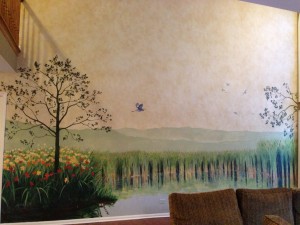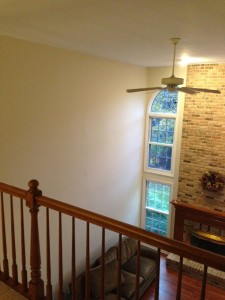The field of decorative finishing has suffered badly during the recession; however things are looking up again. Decorative painting is reemerging as a powerful design tool to beatify one’s environment and provide creative solutions to modern-day building challenges. One of those challenges consists of these two-story walls in foyers and family rooms of contemporary houses.
A client recently posed the following question to our Chicago area painting and decorating company: “I have this 20’ x 20’ wall in my family room – what can I do to make it an appealing feature of my house?” After asking a few additional questions, I was able to ascertain that she was looking for something that would have warmth, be inviting, give a feeling of depth to the room and be nurturing to her. I went to my van and brought back a sample board for a one of our signature finishes: a sanded-texture finish, combined with hand-painted mural elements. I explained that the texture and mottled color of the finish would add warmth and a comfortable feel to the wall, while creating a wonderful background for a mural on the lower portion of the wall. She loved the idea!
After probing further, it turns out that our client had a pretty good idea of what she would like as mural elements: wetlands, cattails, tiger lilies, a blue heron and silhouette of trees in the foreground. Following our meeting, we both went online and searched for images to give more definition to her vision for the mural – we did find many images. The more challenging elements were the silhouettes the client had envisioned. One of the images made the concept clear: In nature, when a larger object is in the foreground, it is sometimes deprived of light and appears as a darker, single color, like a silhouette. Having grasped that concept, we proceeded to develop a watercolor rendering for the mural. Our client loved it and kept it on her computer until we were able to schedule her project!
Decorative finishing and murals in particular are powerful tools to help transform the mood of a space. Our client happened to come home as we were pulling up the tarps. When she got choked up while talking about her mural, we knew we had “hit the spot” for her.










 Follow
Follow

